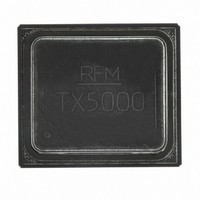TX5000 RFM, TX5000 Datasheet - Page 3

TX5000
Manufacturer Part Number
TX5000
Description
ASH TX 115.2 KBPS 433.92 MHZ
Manufacturer
RFM
Series
TXr
Datasheet
1.TX5000.pdf
(6 pages)
Specifications of TX5000
Frequency
433.92MHz
Applications
General Data Transfer
Modulation Or Protocol
ASK, OOK
Data Rate - Maximum
115.2kbps
Power - Output
0dBm
Current - Transmitting
7.5mA
Data Interface
PCB, Surface Mount
Antenna Connector
PCB, Surface Mount
Voltage - Supply
2.2 V ~ 3.7 V
Operating Temperature
-40°C ~ 85°C
Package / Case
SM-20L
Number Of Receivers
1
Number Of Transmitters
1
Wireless Frequency
433.92 MHz
Operating Supply Voltage
3.3 V
Maximum Operating Temperature
+ 85 C
Mounting Style
SMD/SMT
Maximum Data Rate
115.2 Kbps
Minimum Operating Temperature
- 40 C
Modulation
OOK/ASK
Lead Free Status / RoHS Status
Lead free by exemption / RoHS compliant by exemption
Features
-
Memory Size
-
Lead Free Status / Rohs Status
Lead free / RoHS Compliant
Other names
583-1096-2
www.RFM.com
©2008 by RF Monolithics, Inc.
Transmitter Theory of Operation
Introduction
RFM’s TX-series hybrid transmitters are specifically designed for
short-range wireless data communication applications. These
transmitters provide robust operation, very small size, low power
consumption and low implementation cost. All critical RF functions
are contained in the hybrid, simplifying and speeding design-in.
The transmitters can be readily configured to support a wide
range of data rates and protocol requirements. TX-series
transmitters feature excellent suppression of output harmonics and
virtually no other RF emissions, making them easy to certify to
short- range (unlicensed) radio regulations.
Transmitter Block Diagram
Figure 1 is the general block diagram of the transmitter. Please
refer to Figure 1 for the following discussions.
Antenna Port
The only external RF components needed for the transmitter are
the antenna and its matching components. Antennas presenting
an impedance in the range of 35 to 72 ohms resistive can be
satisfactorily matched to the RFIO pin with a series matching coil
and a shunt matching/ESD protection coil. Other antenna
impedances can be matched using two or three components. For
some impedances, two inductors and a capacitor will be required.
A DC path from RFIO to ground is required for ESD protection.
Figure 1
E-mail: info@rfm.com
Resonator
Coupled
TXA1
SAW
TX
IN
Transmitter Block Diagram
R
& Bias Control
TXM
Modulation
TRL1
CN
TXA2
TRL0
CN
Transmitter Chain
The transmitter chain consists of a SAW coupled-resonator
oscillator followed by a modulated buffer amplifier. The SAW
coupled resonator output filter suppresses transmitter harmonics
to the antenna.
Transmitter operation supports two modulation formats, on-off
keyed (OOK) modulation, and amplitude-shift keyed (ASK)
modulation. When OOK modulation is chosen, the transmitter
output turns completely off between “1” data pulses. When ASK
modulation is chosen, a “1” pulse is represented by a higher
transmitted power level, and a “0” is represented by a lower
transmitted power level. OOK modulation provides compatibility
with first-generation ASH technology, and provides for power
conservation. ASK modulation must be used for high data rates
(data pulses less than 200 µs). ASK modulation also reduces the
effects of some types of interference and allows the transmitted
pulses to be shaped to control modulation bandwidth.
The modulation format is chosen by the state of the CNTRL0 and
the CNTRL1 mode control pins, as discussed below. In the OOK
mode, the oscillator amplifier TXA1 and buffer amplifier TXA2 are
turned off when the voltage to the TXMOD input falls below 220
mV. In the OOK mode, the data rate is limited by the 20/15 µs turn-
on and turn-off time of the oscillator. In the ASK mode TXA1 is
biased ON continuously, and the output of TXA2 is modulated by
the TXMOD input current. Minimum output power occurs in the
ASK mode when the modulation driver sinks about 10 µA of
SAW
Filter
CR
Tune
Ant
Antenna
Tune/ESD
TX5000 - 4/3/08
Page 3 of 6













